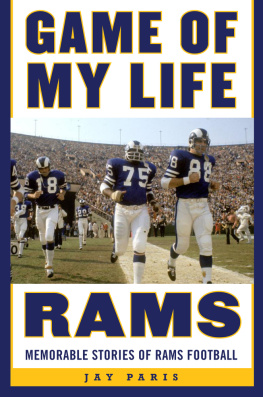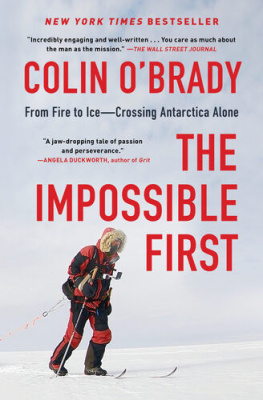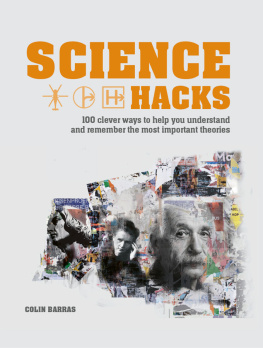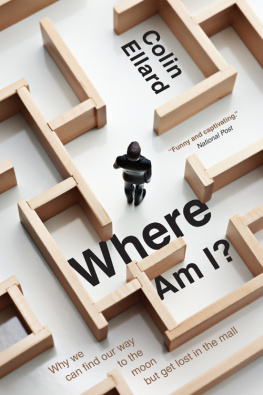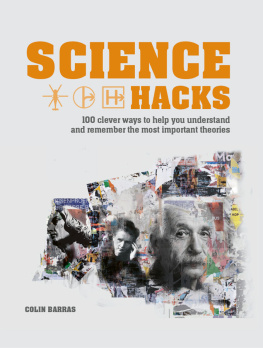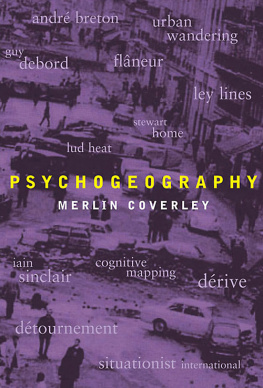PRAISE FOR COLIN ELLARD

One of the finest science writers Ive ever read.
Los Angeles Times
Delightfully lucid.... Ellard has a knack for distilling obscure scientific theories into practical wisdom.
New York Times Book Review
[Ellard] mak[es] even the most mundane entomological experiment or exegesis of psychological geekspeak feel fresh and fascinating.
NPR
[Ellard] entertain[s] us with an explanation of the cold, hard science of navigation [and] artfully constructed exploration[s] of how our relationship to spaces plays a huge part in making us human.
Quill & Quire
Ellard writes with admirable clarity.
Kirkus Reviews
Ellard makes it clear that the space around us has made us the species we are.... Witty and engaging and crammed with profound insights.
Michael Brooks, author of 13 Things that Dont Make Sense:
The Most Baffling Scientific Mysteries of Our Time
[Ellard] took me on a journey to places Id never even considered before.
Sarah Susanka, author of The Not So Big House

First published in the United States in 2015 by
Bellevue Literary Press, New York
For information, contact:
Bellevue Literary Press
NYU School of Medicine
550 First Avenue
OBV A612
New York, NY 10016
2015 by Colin Ellard
Library of Congress Cataloging-in-Publication Data is available from the publisher upon request
All rights reserved. No part of this publication may be reproduced or transmitted in any form or by any means, electronic or mechanical, including photocopy, recording, or any information storage and retrieval system now known or to be invented, without permission in writing from the publisher, except by a reviewer who wishes to quote brief passages in connection with a print, online, or broadcast review.
Bellevue Literary Press would like to thank all its generous donorsindividuals and foundationsfor their support.

The New York State Council on the Arts with the support of Governor Andrew Cuomo and the New York State Legislature

This project is supported in part by an award from the National Endowment for the Arts.
Book design and composition by Mulberry Tree Press, Inc.
First Edition
1 3 5 7 9 8 6 4 2
ebook ISBN: 978-1-942658-01-6
For Kristine
Contents

PLACES OF THE HEART
The Psychogeography of Everyday Life

W HEN I WAS SIX YEARS OLD and before I had even thought once about how I wanted to spend my life, my father took me to visit Stonehenge. Our visit took place about fifty years ago, long before there was any kind of regulation or control of the sitenot even a fence. Early one spring morning, we stood together on the empty Salisbury Plain, walked among the giant pillars of stone, and ran our hands over their smooth surfaces, saying very little to each other. No words were required. It was enough to be there. I was too young to have any clear understanding of the gulf of time that separated us from the sites creators, and my mind was uncluttered by the years of schooling and the accretion of complicated mental associations that when I was an adult would make it so much more difficult for me to be in the simple presence of a monument, allowing the feelings that it engendered to wash over me. I knew I was in the presence of something old and important and it was clear to me that whoever had shaped and raised these giant stones had meant businessthe effort required to build this thing spoke volumes. I knew very little then about the mysteries surrounding Stonehenge; though my curiosity about this gradually mounted, on my first exposure to the site, questions about its purpose mattered little to me. I was preoccupied with the feelings I experienceda sensation of smallness even greater than that normally felt by a little boy holding his fathers hand in a strange place, some breath-quickening anxiety, perhaps produced by the awareness that I was stepping among stones that must have been laid out by others for some great purpose that they never intended to share with me. I wanted to move around the pillars, peer up at their peaks, explore their surfaces, while at the same time I had a deliciously creepy feeling that perhaps we shouldnt be there at allthat the giants who made this place might soon return.
My father, a worker in the building trades, probably had a different kind of experience that day. When I was very young, I was only vaguely aware of what he did for a living, but I learned enough about his work in my teen years to understand that it was hard for him to look at any kind of built structure without calculating, making a mental inventory of the sizes and shapes of the materials that had been used, and thinking about the sturdiness of a structure and its ability to stand up to the elements and to simple human use. My father was a quantity surveyor, and it was his job to understand measurement, cost, and value in an architects blueprint and to participate in the work that would ensure that the final building both lived up to the architects vision and came in at or under budget. I think it was possible for him to experience a simple emotional response to a building, but it must always have been separated by a membrane of detachment from his complicated intellectual response grounded in engineering, architecture, and economics.
Many years later, I find myself in a remarkably similar situation to what I think my father must have felt that day on the plains of Salisbury. Im something of an architecture and design groupie. Im fascinated by the range of effects the design of a building or a streetscape can exert on my feelings and my thoughts; Ive traveled the world keen to experience these effects firsthand. Professionally, Im an experimental psychologist who studies the ways that buildings influence those who use them. I employ a wide-ranging set of scientific tools to get an insiders view of the human response to place. I can tell when the occupants of a building are paying attention (and what theyre paying attention to), I know when they are feeling excited, bored, happy, sad, anxious, curious, or intimidated. My mission is to try to figure out the connections between the bricks and mortar that my father measured with such care and the inner workings of the minds of the people who witness them.
I find myself constantly crossing back and forth over a line that separates my simple six-year-old wonder and emotional response to the built world and my critical response as an adult scientist working in the field. One of my main objectives in this book is to describe both sides of this line to you. Almost everyone in the world experiences built space on a daily basisin our homes, our workplaces, our institutional buildings, and our places of entertainment and education. We all share at least a vague sense that the way in which such settings are designed exerts an influence on how we think and what we do, and we will often seek out particular settings precisely because we want to experience those influences (think of churches and amusement parks, for instance). But even though we all feel and respond to the design of a building at an emotional level, and even though those feelings influence what we do when we are there, we most often dont have the time or the inclination to dissect our daily responses to place to make sense of them.
Next page

